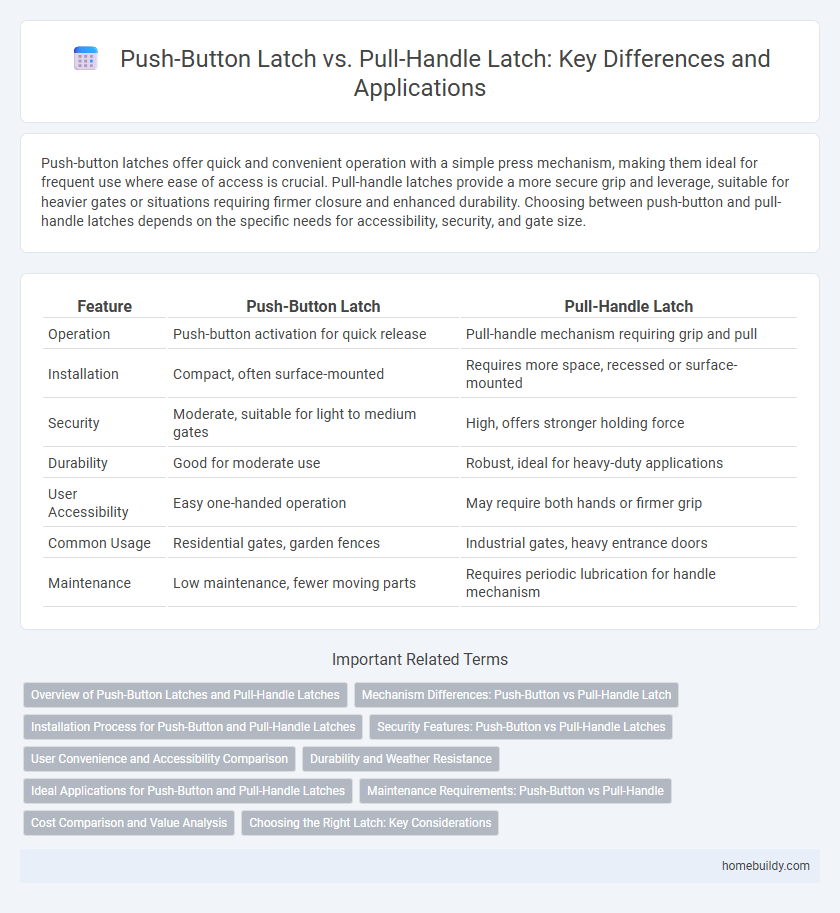Push-button latches offer quick and convenient operation with a simple press mechanism, making them ideal for frequent use where ease of access is crucial. Pull-handle latches provide a more secure grip and leverage, suitable for heavier gates or situations requiring firmer closure and enhanced durability. Choosing between push-button and pull-handle latches depends on the specific needs for accessibility, security, and gate size.
Table of Comparison
| Feature | Push-Button Latch | Pull-Handle Latch |
|---|---|---|
| Operation | Push-button activation for quick release | Pull-handle mechanism requiring grip and pull |
| Installation | Compact, often surface-mounted | Requires more space, recessed or surface-mounted |
| Security | Moderate, suitable for light to medium gates | High, offers stronger holding force |
| Durability | Good for moderate use | Robust, ideal for heavy-duty applications |
| User Accessibility | Easy one-handed operation | May require both hands or firmer grip |
| Common Usage | Residential gates, garden fences | Industrial gates, heavy entrance doors |
| Maintenance | Low maintenance, fewer moving parts | Requires periodic lubrication for handle mechanism |
Overview of Push-Button Latches and Pull-Handle Latches
Push-button latches provide secure gate closure with a simple, single-motion push mechanism that can be locked or unlocked without a key, making them ideal for quick access and frequent use. Pull-handle latches feature a handle that must be gripped and pulled to release the latch, offering enhanced control and durability for heavier gates or those requiring firmer security. Both types are commonly made from corrosion-resistant materials such as stainless steel or zinc alloy, ensuring longevity in outdoor environments.
Mechanism Differences: Push-Button vs Pull-Handle Latch
Push-button latches operate by pressing a button that releases an internal catch mechanism, allowing the gate to open smoothly. Pull-handle latches require lifting or pulling a handle to disengage a spring-loaded catch, providing a firm hold when closed. The push-button latch offers quick one-handed operation, whereas the pull-handle latch often delivers greater mechanical advantage for sturdier gate security.
Installation Process for Push-Button and Pull-Handle Latches
Push-button latches typically require drilling a hole through the gate frame to accommodate the button mechanism, followed by securing the latch body with screws, making the installation straightforward but precise in positioning. Pull-handle latches often demand additional steps, such as aligning and fixing the handle on one side and the latch strike plate on the gatepost, sometimes necessitating more complex measurements for proper functionality. Both latch types benefit from using corrosion-resistant screws and ensuring the alignment of moving parts to guarantee smooth operation and long-term durability.
Security Features: Push-Button vs Pull-Handle Latches
Push-button latches typically offer enhanced security features such as tamper-resistant mechanisms and automatic locking, reducing the risk of unauthorized access. Pull-handle latches often rely on manual locking and are generally easier to bypass, making them less secure in high-risk environments. Choosing a push-button latch boosts gate security by integrating locking and release controls in a single, tamper-proof unit.
User Convenience and Accessibility Comparison
Push-button latches offer enhanced user convenience with one-handed operation and quick access, ideal for users requiring swift and simple gate control. Pull-handle latches provide better grip and leverage, benefiting individuals with limited dexterity or strength by requiring a natural pulling motion. Both latch types improve gate accessibility but cater to different user needs based on ergonomic preferences and physical capabilities.
Durability and Weather Resistance
Push-button latches feature a compact design with sealed mechanisms that offer superior durability and enhanced weather resistance, making them ideal for outdoor gates exposed to harsh conditions. Pull-handle latches, while often easier to grip, typically have more exposed components that may be vulnerable to rust and wear from prolonged weather exposure. Choosing a latch with stainless steel or zinc-plated materials significantly improves corrosion resistance and extends the lifespan of both push-button and pull-handle models.
Ideal Applications for Push-Button and Pull-Handle Latches
Push-button latches are ideal for applications requiring quick, one-handed operation and secure closure, commonly used in cabinet doors, lockers, and access panels. Pull-handle latches excel in scenarios demanding higher leverage and ease of grip, such as gates, toolboxes, and heavy doors where stronger force is necessary to open or close. Selecting between push-button and pull-handle latches depends on the user's need for convenience versus mechanical advantage in the specific gate or door context.
Maintenance Requirements: Push-Button vs Pull-Handle
Push-button latches require minimal maintenance due to their simple mechanical design and fewer moving parts, reducing the risk of malfunction over time. Pull-handle latches often need more frequent inspections and lubrication to ensure smooth operation, especially in outdoor environments prone to dirt and moisture buildup. Choosing a push-button latch can lower long-term maintenance costs and enhance reliability in gates exposed to varying weather conditions.
Cost Comparison and Value Analysis
Push-button latches typically offer a lower upfront cost due to simpler mechanisms and mass production, making them budget-friendly for standard gate applications. Pull-handle latches, while often more expensive, provide enhanced durability and ergonomic comfort, delivering greater long-term value in high-traffic or heavy-duty gates. Selecting between the two hinges on balancing initial expenditure against maintenance needs and user experience for optimal cost-effectiveness.
Choosing the Right Latch: Key Considerations
Push-button latches offer convenient one-handed operation and are ideal for gates requiring quick access or frequent use, ensuring secure closure with minimal effort. Pull-handle latches provide stronger grip and leverage, making them suitable for heavier gates or environments where extra force is needed to open the latch reliably. When choosing the right latch, consider gate weight, frequency of use, security needs, and installation environment to ensure optimal functionality and durability.
push-button latch vs pull-handle latch Infographic

 homebuildy.com
homebuildy.com